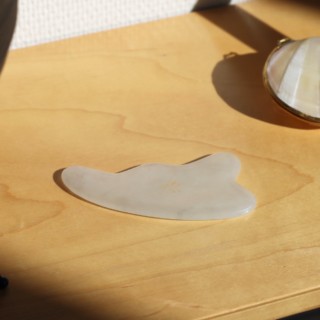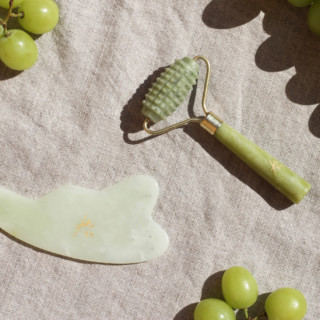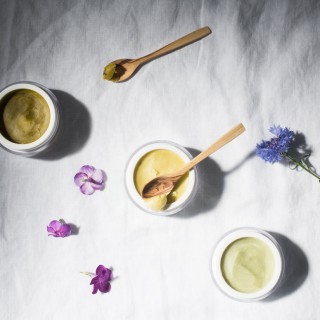A good gua sha tool is like an extension to the hand. A high-quality tool is shaped to target even the finest layers of connective tissue. Use this guide to find the perfect tool for you.
When I was still fairly new to facial gua sha, the tool felt a little clumsy in the hand when doing treatments for others. After all, there is an object between my hand and the customer’s skin. But our somatosensory system is pretty incredible. After a while, you begin to tap into the sense of touch and take note of even the most delicate sensations: what tension feels like in connective tissue and stiffness in the matrix. How about puffiness and, above all, blockages becoming released and energy getting to flow freely? In gua sha, the other hand follows continually along either as an anchor or palping the skin, yet sensations can be felt through the tool in the hand. It’s why I refer to a gua sha tool as an extension to the hand. There are some fascinating studies on sensing touch through a tool.
An increased awareness of the skin has been reported also by Yin Your Skin® course members, especially by the participants in my three-week gua sha challenge on Facebook.
Facial gua sha has the potential to reap amazing results (why not check out some before and after images in my Instagram highlights). But achieving results requires regular treatment and mastering the right technique. The results accumulate in the long-term, and also the technique becomes honed along with regular practice. The Yin Your Skin® course will teach you the basic techniques for a facial gua sha. I warmly recommend the course if you want to learn the technique properly. Course members also have the possibility to reserve individual coaching with me, where they receive a personally tailored treatment we then go through together in detail. My live coaching sessions have highlighted the need for face-to-face individual coaching for each and every one. So, to become a master in gua sha, the course is worth the investment, and you’ll find the instructions accompanying gua sha tools pale in comparison.
The majority of questions I get are about finding the right gua sha tool. I recently updated the descriptions of the Yin Your Skin® gua sha tools to be more detailed, and I plan to add tips on choosing a suitable tool. As I’ve said before: Don’t just buy a tool, but learn to use it. The Yin Your Skin® online course is the best way to learn.

Yin Your Skin® gua sha tools
JALO Advanced Gua Sha Facial Tool
Jalo is the latest addition in the Yin Your Skin® range of tools. It is a fusion of all the other tools in the collection. The idea was sparked by the wavy LAHJA facial tool. When treating my own skin, I started to think up ways the tool could be even better. Using Lahja as a mould, I began to sketch a new tool on paper, adding new features I envisioned. The tool was refined together with the factory for six months before it found its final, perfected form. I’ve tested most gua sha tools on the market, some of which have very complex designs – too complex in fact. Jalo has everything I feel a perfect facial gua sha tool needs, and the feedback I’ve received has indicated the same.
Jalo is heavier and thicker than the other Yin Your Skin® tools. The weight of the stone is all the pressure you need for treatment. The thin, tapered edges mean you can apply pressure at exactly the right depth in loose connective tissue. The thin edge also ”grabs” the skin along as needed when applying a sweeping action. The wavy edge is the perfect fit with the trapezius and back of the neck, and my Chinese medicine teacher even noticed that it fits like a glove with the Gallbladder 20 points. The hook-shaped end is great for precision treatment of the corners of the mouth, nasolabial skin and skin around the eyes and under the chin, and is a nice fit around the ears. The U-shaped edge wraps around the cervical spine and tip of the chin. The serrated edge softens any stiffness in the matrix, improving fluid flow and skin mobility, and is suitable for scraping lines and wrinkles.
Jalo is the top choice for demanding users, professionals and anyone after the best possible results.

NIVA Gua Sha Spoon
The Niva spoon is the most essential tool alongside the Jalo tool and the number one choice for treating sensitive skin, acne, atopic skin, rosacea and perioral dermatitis. It’s a perfect fit for the skin around the eyes and key tool for removing puffiness. There is a special technique for treating sensitive skin and removing puffiness with a focus on invigorating lymph flow, i.e. the flow of metabolic waste and other unwanted substances away from tissues. The plump shape of the tool coupled with a wavy pumping technique make it unparalleled. It is gentle for sensitive skin, as the edge won’t catch onto the skin. The thin, tapered edges mean the tool can also be used for treating sagginess and wrinkles. The end is excellent for treating the scalp, while the handle boosts treating under-eye skin and targeting acupuncture points.
LAHJA Gua Sha Facial Tool
The wavy Lahja facial tool is a wonderful general purpose tool, which is a good choice for beginners and lazier gua sha experimenters. The wavy edge is shaped to conform to the anatomy of the face and the perfect fit for treating the bone structure of the face, jawbone, cheekbones and skin around the eyes. The hook-shaped end gently boosts precision treatment, while the U-shaped end wraps around the cervical spine and tip of the chin. Lahja is a delicate and handy tool, its thin shape making it gentle and efficient.

LOVI Gua Sha Comb
The Lovi comb is a classic gua sha tool suitable for treating the entire body from head to toe. If after a spot of traditional Chinese medicine-based gua sha, Lovi is your go-to tool. It can also be used for an efficient, skin-firming gua sha treatment for the face. The simple design with no extra gimmicks makes it great for a basic gua sha or to be used as a first tool. The comb part has the potential to take you to nirvana; combing the scalp (or soles of the feet) feels heavenly and invigorates the nervous system in just a few strokes.
KUULAS Gua Sha Jade roller
I end up using the Kuulas roller the least, as it doesn’t bring the same results as a flat gua sha tool. But the spikes of the Kuulas roller soften the matrix, improving fluid flow and circulation. Kuulas is suitable as a quick beauty fix, “pre-softener” before the actual gua sha treatment, or at the end of a treatment to seal a super glow on the skin. The Yin Your Skin® course members’ Facebook group includes an advanced treatment for making the most of a roller. The Kuulas roller is not suitable for sensitive skin or problem skin like acne, atopic skin, rosacea and perioral dermatitis.
Taking Care of Gua Sha Tools
After each use, wash the tools with soap and water and dry carefully. You can also spritz them with disinfectant. If treating others, careful disinfecting is vital. Store the tools safely in their own box or a tiny pouch. The tools are eternal, but can easily break if dropped on the floor.

How Often Can I Do a Gua Sha Treatment?
For a facial gua sha, I recommend a good kickstart at the beginning to really get to see results and learn the technique. You could start with a daily treatment for a course of three weeks. Observe your skin during this time: a long, thorough treatment isn’t necessary every day, and some days you may benefit from focusing on selected areas of the skin. Leave sore areas or painful lymph points untreated. If the treatment makes them sore, it is a sign of too much pressure or the treatment simply being too much for the time being. After a 3-week kickstart, maintain the results with 2–3 sessions a week. A facial gua sha is a bit like hitting the gym: going now and again brings a feelgood factor and instant results that do not last –you need regularity and maintenance.
At the beginning, impurities can surface along with improved metabolism of the skin. Skin has a secretion function, meaning that metabolic waste can become removed through the skin. In this case, carry on with regular treatments working around blemishes and treating underneath them instead. Impurities can begin to swap places – they commonly move downwards. They will gradually disappear.
I would love to hear about your favourite tools and the results you have gained with facial gua sha?
Photos Riikka Kantinkoski
Translation Rebecca Watson














